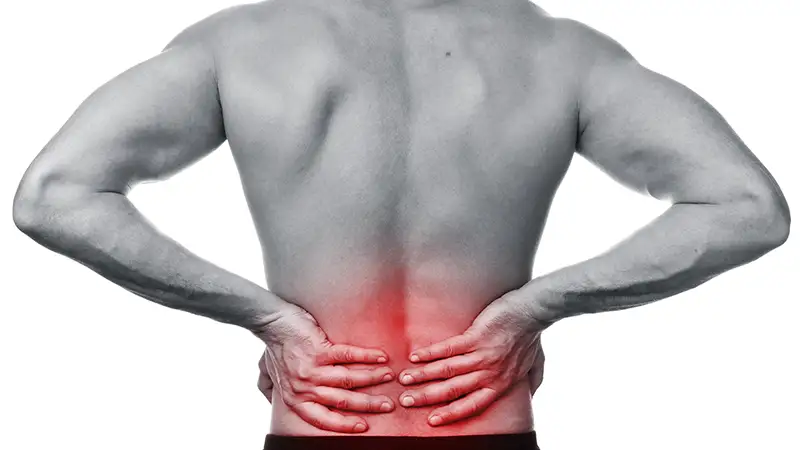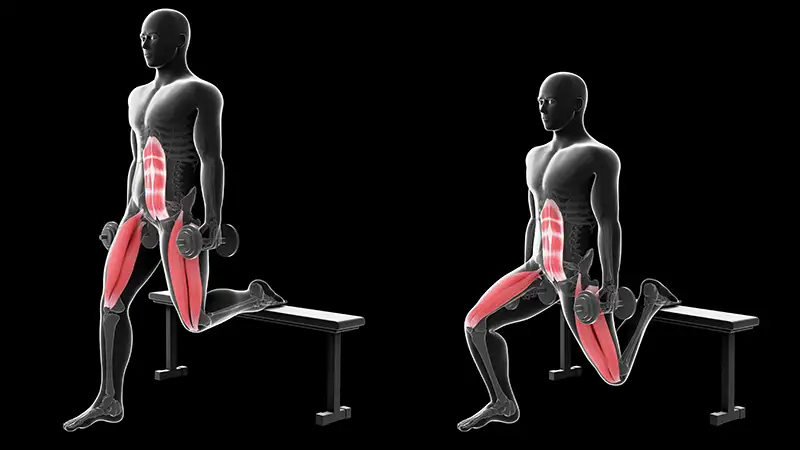Contents
Depending on your age and level of health, it is likely that you have experienced back pains of some sort in your life, and for many, this has occurred more than once.
While there can be obvious reasons for the uncomfortable state, one of the questions that people may search for an answer to is, can weak glutes cause lower back pain?
What Are The Glutes and What Do They Do?

From Jennifer Lopez to Beyonce, Chris Hemsworth to Channing Tatum, everyone is looking for a tighter, more shapely booty.
And if you are an athlete, well, your caboose is one of your most powerful and biggest muscle groups.
Made up of the gluteus maximus, medius, and minimus, the gluteal muscle group gives your bottom its shape, form, and power.
While they help us give the look of a tight firm toosh, the glute muscles serve several more essential and functional purposes.
Besides helping our bodies sit, stand and move, our glutes work to abduct, adduct, extend, and externally and internally rotate our thighs.
How Do The Gluteus Muscles Help Our Backs?
Having strong, well-maintained gluteus muscles assist with the movement patterns of your pelvis, hip, and trunk.
The Gluteus maximus assists with hip movement, while the medius controls pelvic movements and the minimus handles hip stabilization and abduction.
The gluteal muscles also assist with good posture by evenly distributing the weight load throughout your lower back and extremities.
Besides supporting the lower back, strong glutes will also help eliminate compression and soreness of the lumbar spine.
Is Your Lower Back Pain Caused By Weak Glutes?

Have you ever gone to your doctor, physical therapist, or trainer asking “can weak glutes cause lower back pain”, they will all come back to you with the same answer, yes!
We often attribute hip and pelvis imbalance along with an unstable and sore lower back to weak, inactive, and tight glute muscles.
While prolonged sitting can often lead to tight and inactive glutes, overtraining of the muscle group can lead to causing extreme tightness, all of which equates to lower back pain and discomfort.
When your glute muscles aren’t firing properly, tissues in the lower back and pelvis become impacted, resulting in a lateral tilt, as they tend to over-absorb various forms of impact during your daily activities that they normally should not.
As a result of pelvic imbalance, the small curvature and rotation of the lower back can cause lower back pain during even the simplest of movements.
With unstabilized or weak glute muscles, the pelvis can become mechanically overloaded, which can also result in long-term injuries.
How To Tell If You Have Weak Glutes
There are a number of signs that may hint that you have weak glute muscles.
Lower Back Pain
As we already addressed, if you are dealing with lower back pain, be it during daily routine movements or during exercise, it is likely because your glute muscles are not firing properly or are weak.
Hip And/Or Knee Pain
While there are other things that can contribute to hip and knee pain, having a set of weak glutes can cause stress and strain on joints, including hips, knees, and ankles.
Poor Posture
Through the pelvis and trunk, weak glutes can contribute to poor posture causing you to hunch or slouch over.
Tightness
Chronically tight or sore glutes are often a sign that they are weak and underdeveloped.
Balance
If you have trouble maintaining a stable pelvis while engaged in single-leg activities such as standing on one leg, jumping, hopping, walking, or running, we can relate the lack of stability to weak glutes.
Abnormal Gait/Plantar Fasciitis/Blisters
Any of these three could be a sign that you have weak glutes.
Lack of firepower from our glutes could contribute to poor mobility and stability of the hip joint which could throw off your gait.
This could cause abnormal foot strike movement while running, causing pain and inflammation in the heels.
Both issues can cause blisters while walking or running.
How Did I Get Weak Glutes?

The simple answer is you probably haven’t worked on them.
Just as with any muscle group in your body, if you don’t use them, they become weak and falter, causing related issues in other areas.
A telltale reason behind weak glutes is a sedentary lifestyle and lack of activity.
Whether you work a 9-5 desk job, drive for a living, are a student, or are simply a couch potato binge-watching streaming shows, there are a lot of reasons more and more people are sitting around more than they should.
With advances in technology and the demand for more work hours, be it in the office or at home, people are finding more reasons not to hit the gym or at the very least get out for a walk.
Glute Strengthening Exercises
Alright, let’s help your lower back by building up that booty!
The great thing about glute-focused exercises is that you can do most of them at home with little equipment.
You can alter each of these exercises and have plenty of challenging variations with the addition of weights, resistance bands, or the height of the bench.
Squats

Begin with your feet shoulder-width apart. You can clasp your hands in front of your chest or place them on your hips.
Slowly bend your knees, dropping your hips and lowering your butt backward as if you were to sit in a chair. Focus on not letting your knees collapse inward or protrude over your toes.
Aim to have your thighs parallel to the ground. As you reach this point, push through your heels to stand back up.
Donkey Kicks

Start in a table-top position with your hands inline with your shoulders and knees directly under your hips.
Maintain a flat back and keep your core engaged.
Lift one leg off the floor, hinging at the hip, keeping your knee bent and foot flat.
Using your glute, press your foot upwards and squeeze your glute at the top.
Make sure that your pelvis and hip stay square to the floor.
Return to the starting position and repeat for reps.
Glute Bridge

Considering it has the word glute in the name, this is a very simple yet effective exercise for strengthening and activating your glutes.
Begin laying on your back with your knees bent and your feet flat on the ground, hip-width apart.
Aim to have your feet approximately 6-8 inches from your bottom.
Should you feel the hamstrings working more than your glutes, bring your heels closer to your glutes.
Keep your arms at your sides.
As you squeeze your glutes and engage your core, raise your hips off the ground as high as you can without creating an arch in your back.
Ideally, you want to have a straight line from your shoulders, hips, and knees.
At the top of your lift, squeeze your glutes for two seconds, before you slowly lower your hips down to the starting position.
Barbell Hip Thrusts
Wrap the barbell with a squat pad or towel prior to performing the exercise for more comfort.
Begin by sitting on the floor with your upper back against the edge of a bench (placed parallel behind you) with your knees bent and feet flat on the floor, hip-distance apart.
Place the weighted bar across the crease of your hips. You can hold on to the bar to keep it balanced.
As you squeeze your glutes, drive both feet into the floor, lifting your hips until they are in line with your shoulders and knees.
Keep your chin tucked slightly into your chest and engage your core.
Slowly lower your hips back down until they are a couple of inches off the ground and repeat for reps.
Bulgarian Split Squats

You can do this exercise using a pair of dumbbells (holding at your side) or a barbell (placed on your shoulders).
Standing approximately one long step in front of a bench or a plyo box, place one foot on the bench behind you.
You can either use the ball of your foot or place the face of your foot flat on the bench.
You may have to adjust your front foot by shimming it forward or back for proper distance.
Slowly bend the front knee into a squat position, keep your hips square and core engaged while lowering the back knee until it is just a couple of inches above the ground.
Do not allow your front knee to move in front of your toes.
As you rise back up, drive through your front foot heel into an upright position. Repeat for reps with the same leg, then switch.
Deadlifts
Stand behind the loaded barbell with your feet shoulder-width apart.
With your chest lifted, squat down and grip the barbell with either a doubler overhand grip or a mixed grip with one palm facing forward, and the other towards you.
With your feet flat on the floor and sitting back into your hips, maintain a flat back as you shoot your hips forward into a proper standing position.
Your legs should become straight and your shoulders should be rolled back and down with the bar hanging in front of you, just below hip height.
To return to your starting position, keep your back straight as you shoot your hips back and bend your knees slightly as you return the bar to the ground.
